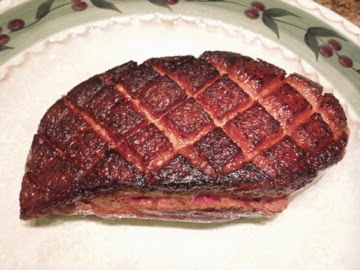Two Ways to Prepare Duck Magret Breast
We have decided we simply cannot justify spending a lot of
money at restaurants for duck breast anymore!
Before the holidays, we ordered from Costco (online)
D’Artagnan’s Duck Magret Breast and Duck Leg Confit. The package contained 6 huge duck breasts and
6 (sadly, just normal sized) duck leg confit.
All for $129.99. Once you get
over the initial shock that there is a triple digit price tag, you realize that
each duck breast is plump enough to feed two adults with healthy
appetites. That means that, combined
with the confit legs, you have 18 individual dinners. That’s just $7.22 per each delectable,
highest quality duck dinners!
We love duck confit and have gads of uses for them (and more
on duck confit on another post). On the
other hand, we don’t usually cook duck breast at home. In part, I think it’s because we didn’t
really have a reliable source for good duck breast. That’s why it was heartening to see all those
amazing reviews about the D’Artagnan package.
We felt comfortable, like we weren’t putting our health at risk by
cooking up iffy duck breasts at medium-rare.
Weather wasn’t horrendous on Christmas (the way it is in
Chicago this week), so for our special holiday dinner we grilled the duck breast
on our Weber. We read from reviews that
this was a good way to make sure that the fat drained away from the duck rather
than having the meat sit in its own fat while cooking. The downside of the grilling was the flaring. The duck breast has an amazing layer of fat,
and the fat caused so many flare-ups that the duck was a bit scorched—even with
Will checking on it constantly outside in the cold. The result, scorched or not, was something
that tasted like the best medium-rare rib-eye!
Yummy.
As timing would have it, while we were patting ourselves for
our first successful duck breast dinner at home, we came across the January
2014 issue of Bon Appetit in which
the magazine recommended pan-frying as the simplest method to cook duck. Fresh from our recent success—and suffering
from sub-zero temperatures outside—we decided to cook in the kitchen a second duck breast. Normally we don’t like to repeat a dish so
soon after having it the first time, but we wanted to experiment with this
other method of cooking the duck while we still remembered the grilled duck.
With both methods, the preparation is the same: Score the
duck fat in a criss-cross pattern and then salt and pepper it. (There is absolutely no need to oil the
duck!) In each case, the fat side goes
on the hot cooking surface first.
On the grill, we cooked pretty much 6 minutes per side—being
very careful about flare-ups when the fat side is down. In our stove-top method, we put the duck (again,
fat side down) in a preheated cast-iron pan over medium heat. If you have the heat at any higher, the
grease spattering might be out of control!
As it was, we kept on draining the fat every few minutes so that the
duck wouldn’t sit in its fat too much—and so that the smoke alarms could be kept
quiet. We kept the breast down for about
10 minutes before we decided that the skin was crispy brown enough to
flip. (Photo at top of post should give
a good indication of how brown and crispy the skin side should be before
flipping.)
Then we gave the flesh side another 6 minutes. (The magazine said 5, but these are very
plump, and I wasn’t keen on seeing it too
rare.) The duck then sat for 8
minutes. The magazine actually said to
let it sit for 10 minutes, but since 5 minutes was perfect for the grilled
breast, we split the difference. We
actually think even 8 minutes was too long.
Otherwise perfect, we felt that the duck was cooler (yes, in
temperature) than it could be—and much cooler than we remember the grilled
breast being. After it rests, slice thinly (above photo should give you an indication of how much meat you will have with one breast) and serve plain or with your favorite sauce.
With the grilled duck, we had brown basmati rice and a vinegary green cabbage slaw with red onion, cilantro, and lime juice (to cut the duck’s fattiness a bit). We also made a sauce of port wine reduction and dried cherry (photo above). With the pan-seared duck (photo below and at the top of post), we had a warm roasted root vegetable salad and a brown rice medley (with black barley and daikon seeds) and drizzled a balsamic reduction glaze over both the duck and the root vegetable salad.
We’ll take a little break from duck breast, but I wouldn’t
be surprised if there is some duck leg confit cassoulet on the way, given all
this frigid weather that makes us hunger for comfort foods…







Comments
Post a Comment